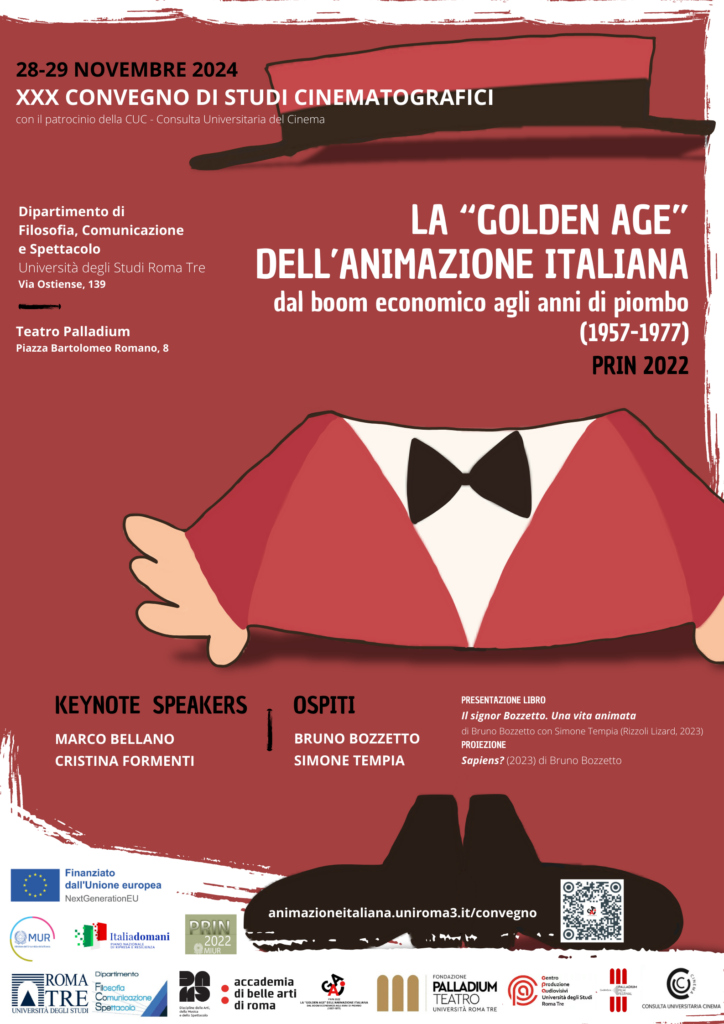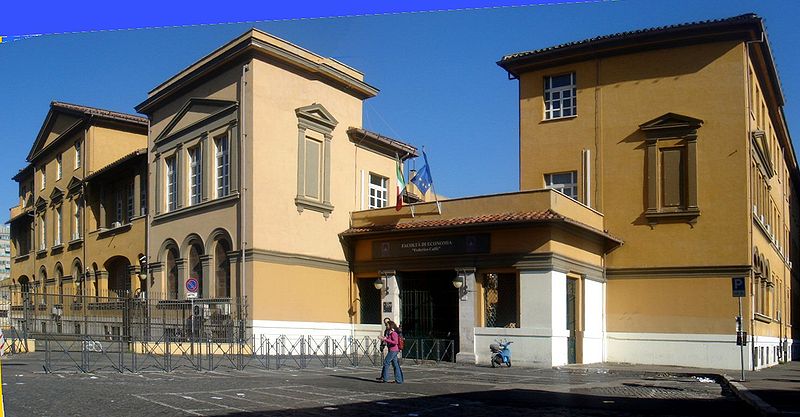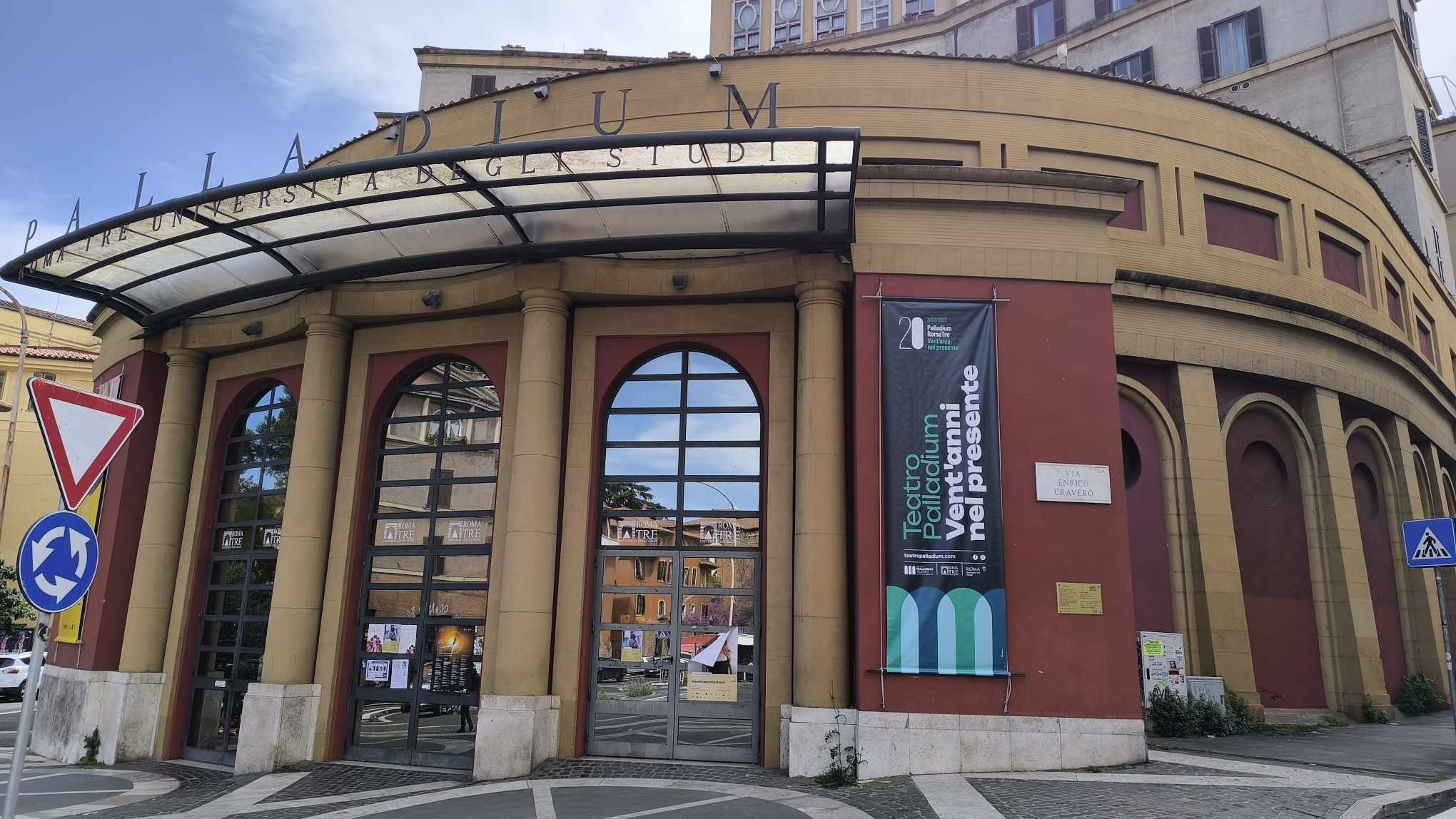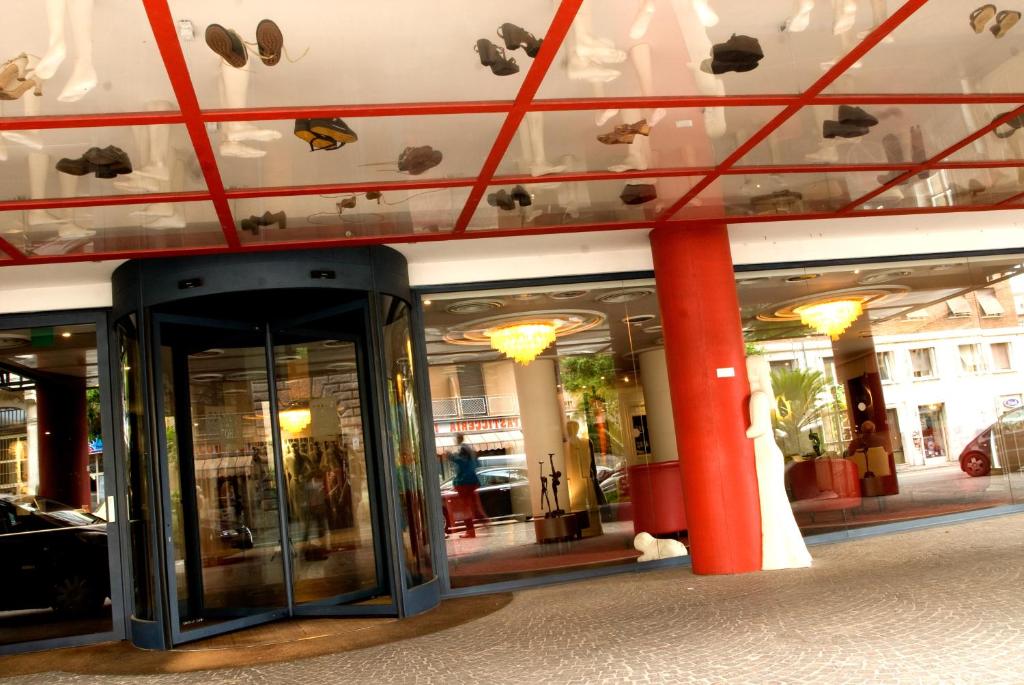
28-29 November 2024
XXX CONFERENCE OF FILM STUDIES
The “golden age” of Italian Animation.
From Economic Boom to the Years of Lead (1957-1977)
The XXX Conference of Film Studies, organised by the Department of Philosophy, Communication and Performing Arts of the Roma Tre University, proposes an exploration of the “golden age” of Italian animation in all its complexity, going to identify the main research trends both in its historical and theoretical aspects, and in its reflections on the productive and industrial scenario, as well as in the forms and practices of this audiovisual area. The Conference thus aims to provide a moment of shared reflection that outlines the state of the art of research on the models, languages, forms and practices of the period on which the PRIN 2022 research project focuses
Department of Philosophy, Communication and Performing Arts
Roma Tre University
Via Ostiense 139 – 00154 Rome
Palladium Theater
Piazza Bartolomeo Romano 8 – 00154 Rome
Thursday, 28th November – Polo aule DAMS
Aula 2.14
14:00
Registration students and speakers
GIACOMO MANZOLI (Head of CUC – Consulta Universitaria del Cinema, Alma Mater Studiorum – Università di Bologna), LUCA AVERSANO (Head of Department of Philosophy, Communication and Performing Arts, Roma Tre University), RAIMONDO GUARINO (Head of Communication and Performing Arts Section, Università degli Studi Roma Tre), ENRICO CAROCCI (Coordinator Degree Course DAMS, Roma Tre University), STEFANIA PARIGI (Roma Tre University), GIACOMO RAVESI (Roma Tre University), CHRISTIAN UVA (Roma Tre University)
14:30 – 15:00
Institutional Greetings
15:00 – 16:40
Panel 1 – Industrie e modelli produttivi
Chair: BRUNO DI MARINO (Accademia di Belle Arti di Roma)
Riflessioni attorno alla produzione e distribuzione del cinema d’animazione italiano degli anni Sessanta
COSIMO TASSINARI (eCampus University)
Through the analysis of funds and repertoires, the paper aims to describe the economic, production and distribution context that enabled the ‘golden age’ of Italian animation cinema in the 1960s
Quando c’era Cinelandia. La Gamma Film tra modelli produttivi e pubblicità animata
MARTINA VITA (Roma Tre University)
The aim of this report is to present an examination of Gamma Film’s production models, explaining the main structuring stages of a cartoon project and the technological practices employed
Tempo e tempi dell’animazione di Carosello
GIUS GARGIULO (Université Paris Nanterre)
In Carosello, the times of stories with their pigtails on the product were a flow of tales of endless consumerist utopias to which the user could get used in order to build a universe of desire around him in the Italy of the economic boom. My communication tends to highlight this transition of stories from a closed frame to that of an open flow through the stories of Calimero, Papalla and other cartoons of the crucial period in the identity formation of the Italian nation
Il sogno animato di Carosello
MARCO GIUSTI (Film Critic)
Those of Carousel are 20 fundamental years, because they go through the Italian economic boom but they also go through Italian cinema. Cinema in 1957 was still, in general, simple and provincial, and in 1977 it is a completely different thing: genres are over, there are no longer any great directors
16:40 – 17:00
Coffee Break
17:00 – 18:30
Keynote Speaker: CRISTINA FORMENTI (University of Groningen)
Il laboratorio Cartoni Animati della Corona Cinematografica: uno studio d’animazione dal respiro internazionale
Respondent: MARCO BELLANO (Università degli Studi di Padova)
The report shows how the Laboratorio Cartoni Animati of Corona Cinematografica constituted a rare example of an Italian animation studio with an industrial character with an international scope. In particular, by bringing animation and European film studies into dialogue, it shows how Fables of Europe offered a model of European animation cinema
20:30
Event in collaboration with the Palladium Film Festival – CineMaOltre
Palladium Theater (Piazza Bartolomeo Romano 8)
Guests: BRUNO BOZZETTO and SIMONE TEMPIA about the book Il signor Bozzetto. Una vita animata (Rizzoli, 2023)
Film Screening: Sapiens? (B. Bozzetto, 2023) – 22′
Friday, 29th November – Polo aule DAMS
Aula 2.14
9:00
Registration students and speakers
9:30 – 11:10
Panel 2 – Società, sistemi culturali e pratiche del consumo
Chair: CHRISTIAN UVA (Roma Tre University)
Animati da serie questioni. Modelli sociali e familiari tra le logiche dell’animazione
VINCENZO ALTOBELLI (Roma Tre University)
The socio-historical processes inherent in the economic prosperity of the 1960s also led to the reification of human facts, establishing a similarity between things and people. The report examines the societal models and family structures represented, visualising the patterns adopted and which conveyed complex and questionable content through the elementary forms of animation
Scandaloso, osceno… eversivo? Forme e codici del pornocartoon italiano
MATTEO SANTANDREA (Roma Tre University)
Starting in the early 1970s, Italian animation found itself subject to a significant infiltration of the sexual subject. But is this eroticism an end in itself or is it possible to trace certain socially subversive instances in such works? Starting from this question, the report focuses on the forms and codes of the so-called Italian pornocartoon
Donne e animazione ai tempi di Carosello
ELENA MARCHESCHI (University of Pisa)
Very few women were recognised as authors in the Italian animation scene, at least until the 1980s. My paper aims to propose the first results of a reconnaissance and analysis of some animation films made between the 1960s and 1970s by artists such as Rosa Foschi, Maria Grazia Hay, Claudia Cossio and Marinella Pirelli
Vignetta o schermo? Questo è il problema…
Solidarietà creativa ed elementi dell’immaginario italiano tra fumetto e animazione
GINO FREZZA (University of Salerno)
The relationship between comics and animation in Italy is decidedly stringent. It is without any priority between one medium and the other. Frezza’s talk reconstructs this relationship by looking at its outcomes after the Second World War, identifying five figures of authors who were able to practise an intermedial relationship with a high cultural profile
11:10 – 11:30
Coffee Break
11:30 – 13:00
Keynote Speaker: MARCO BELLANO (University of Padua)
Il lungometraggio animato in Italia durante la “golden age”
Respondent: CRISTINA FORMENTI (University of Groningen)
The paper examines the style and production context of animated and mixed feature films produced during the ‘golden age’, studying the influence of Bruno Bozzetto, the contaminations with foreign models and above all the processes of variation and refinement of the particular limited animation developed in Italy during the ‘Carosello’ era
13:00 – 15:00
Lunch Break
15:00 – 16:40
Panel 3 – Forme autoriali
Chair: STEFANIA PARIGI (Roma Tre University)
Osvaldo Cavandoli, fedele alla Linea
RAFFAELLA SCRIMITORE (Independent Researcher)
An analysis of the character La Linea, which became part of the collective imagination thanks to Carosello. From the first experiences with animated puppets to the original creation for Carosello and beyond, an in-depth look at the characteristics that make the character La Linea unique as well as Osvaldo Cavandoli’s career in animation cinema
Prima di Carosello. Le pubblicità cinematografiche della Pagot Fllm (1949-1968)
ROBERTO DELLA TORRE (Università Cattolica del Sacro Cuore)
After the failure of the feature film I fratelli Dinamite (1949), Nino and Toni Pagot’s Pagot Film started an intense production of animated and life-like commercials for cinemas. These short works of great visual impact and intense narrative force testify to the new needs of post World War II Italy and the evolution of Italian animation forms
Gianini e Luzzati e l’armonia dell’animazione
SABRINA PERUCCA (Romics Artistics Director)
Giulio Gianini and Emanuele Luzzati, during the years of their artistic partnership, created great masterpieces of animation, made using the découpage technique, which allowed the pictorial qualities of Luzzati’s creations to be preserved. All in an extraordinary connection with music, between Rossini and Mozart. An analysis of their work and some of the works
Dare vita ai disegni e alle idee: lo straordinario caso dello Studio Bozzetto negli anni d’oro di Carosello
ANNA ANTONINI (Independent Researcher)
Buc il Bucaniere, testimonial for Castor washing machines between 1968 and 1969, is a happy example of how Bozzetto Film seized the opportunity offered by Carosello to break free from the limits of advertising, define an original design and ironically contain the blandishments of unbridled progress
16:40 – 17:00
Coffee Break
17:00 – 18:40
Panel 4 – Arti, tecniche e tecnologie animate
Chair: GIACOMO RAVESI (Roma Tre University)
L’animazione italiana della Golden Age come punta più alta del contemporaneo.
GIULIETTA FARA (University of the Republic of San Marino)
Animation cinema in Italy has followed clear paths since its origins, aligning itself with the most important contemporary trends. If we take it for granted that the division between the arts is largely surpassed precisely in the contemporary era thanks to Dadaism, Futurism, Pop Art and so on, then it is natural to liken the animations of Osvaldo Cavandoli, Bruno Bozzetto, the Pagot brothers and Armando Testa to artists such as Dali, Kandinskji, Balla or Mirò. Contemporary art chooses and proposes sharp caesuras with the past, advancing the definition of an art created through sharp lines, strong and flat colours, simple and symbolic figures, if not also abstract. Animation, likewise, follows these tracks faithfully
Tra fasi e passo uno: le quattro tecniche dei Carosello animati (e non solo)
LUCA RAFFAELLI (Journalist and essayist)
The paper examines the four fundamental techniques used in the animated works of the 1960s and 1970s: phase animation and the three of stop motion (puppets, plasticine and cut-out paper)
La musica nella golden age dell’animazione italiana: il caso di Franco Godi
VALERIO SBRAVATTI (Sapienza University of Rome)
Italian animation of the period shows a strong popular musical tendency. With the support of an ad hoc interview, we examine the emblematic case of Franco Godi, a composer specialising in the genre and collaborator of Bruno Bozzetto on several feature films as well as short films dedicated to Mr. Rossi
Animazioni di confine. Dallo schermo al teleschermo, andata e ritorno
FRANCESCO D’ASERO (University of Bari Aldo Moro)
Analysing the main trends of representation and observing some figurative contributions made by the Carosello cartoonists within fictional films, the paper aims to investigate the authorial connections and transmedia dialogues between the animated contents of the TV format and contemporary Italian cinema, exploring practices, models, techniques, graphic approaches and expressive codes capable of drawing a linguistic bridge between the small and big screen
18:40 – 19:00
Database Presentation: La “golden age” dell’animazione italiana
Conclusions
Conference Directors: Stefania Parigi, Giacomo Ravesi, Christian Uva
Coordination: Vincenzo Altobelli, Matteo Santandrea
Staff: Francesco D’Asero, Emanuele Ingrao, Martina Vita
Interns: Chiara Cucinella, Lorenzo Giuliano, Susanna Manca, Emanuela Nicotra
Graphics: Vincenzo Altobelli, Matteo Santandrea
Scientific Committee: Enrico Carocci, Mattia Cinquegrani, Leonardo De Franceschi, Ilaria A. De Pascalis, Lorenzo Marmo, Stefania Parigi, Ivelise Perniola, Marta Perrotta, Veronica Pravadelli, Giacomo Ravesi, Elio Ugenti, Christian Uva
Organisation: Department of Philosophy, Communication and Performing Arts – Roma Tre University
Head of Department: Luca Aversano
Head of Communication and Performing Arts Section: Raimondo Guarino
Administration: Attilio Durpetti (Head), Tiziana Ceriola, Marco D’Alessandro, Patrizia Necci, Andrea Pini, Sara Urdis
Fondazione Roma Tre Teatro Palladium
President: Riccardo Chiaradonna
Board: Giandomenico Celata, Ettore Sergio Giuliani, Maddalena Pennacchia, Christian Uva
Organisation and Logistics: Roberta Incerti
Artistic Organisation: Alessandra De Luca
Communication: Elisabetta Sacripanti
Technical Support: Luca Barbati – EasyLight
Degree Course DAMS
Coordinator: Enrico Carocci
Staff: Elisabetta Ferretti, Aurora Silvestri
Sponsorships
CUC – Consulta Universitaria del Cinema
Prin Project 2022 The “golden age” of Italian Animation. From Economic Boom to the Years of Lead (1957-1977)
Principal Investigator: Christian Uva (Roma Tre University)
Heads of the Research Units: Bruno Di Marino (Accademia di Belle Arti di Roma), Stefania Parigi (Roma Tre University), Giacomo Ravesi (Roma Tre University), Vincenzo Altobelli (Roma Tre University), Matteo Santandrea (Roma Tre University)
Logistic informations:
Hospitality
Abitart Hotel
Via Pellegrino Matteucci 10 – 00154 Roma
https://www.abitarthotel.com/
Transportation
By Train: Roma Ostiense
By Metro:
– Garbatella (Metro B)
– Basilica di San Paolo (Metro B)
